215. Once again. Ogotemmêli
has informed us that the life-force of the
earth, Nummo, was water:
... The life-force of the earth is water.
God moulded the earth with water. Blood too
he made out of water. Even in a stone there
is this force, for there is moisture in
everything. But if Nummo is water, it also
produces copper. When the sky is overcast,
the sun's rays may be seen materializing on
the misty horizon. These rays, excreted by
the spirits, are of copper and are light.
They are water too, because they uphold the
earth's moisture as it rises.
The Pair excrete light, because they are
also light ... 'The sun's rays,' he went on,
'are fire and the Nummo's excrement. It is
the rays which give the sun its strength. It
is the Nummo who gives life to this star,
for the sun is in some sort a star.' It was
difficult to get him to explain what he
meant by this obscure statement. The
Nazarene made more than one fruitless effort
to understand this part of the cosmogony; he
could not discover any chink or crack
through which to apprehend its meaning. He
was moreover confronted with identifications
which no European, that is, no average
rational European, could admit. He felt
himself humiliated, though not disagreeably
so, at finding that his informant regarded
fire and water as complementary, and not as
opposites. The rays of light and heat draw
the water up, and also cause it to descend
again in the form of rain. That is all to
the good. The movement created by this
coming and going is a good thing. By means
of the rays the Nummo draws out, and gives
back the life-force. This movement indeed
makes life
...
The water cycle was good, a statement which
should make us remember the Doublegood Pair:
... In Hindu legend there was a mother
goddess called Aditi, who had seven
offspring. She is called 'Mother of the
Gods'. Aditi, whose name means 'free,
unbounded, infinity' was assigned in the
ancient lists of constellations as the
regent of the asterism Punarvasu.
Punarvasu is dual in form and means 'The
Doublegood Pair'. The singular form of this
noun is used to refer to the star Pollux. It
is not difficult to surmise that the other
member of the Doublegood Pair was Castor.
Then the constellation Punarvasu is
quite equivalent to our Gemini, the Twins
...
Evidently one of the twins stood for Air,
Fire, and a High Sky, i.e. the season of Summer, and the other for a
Low Sky with Water pouring down from above
(Winter),
and in the middle a Tree was standing up.
One of the Twins was in the east and the
other in the west:

But high in the north and far away from
the equator they saw water below and air
above:

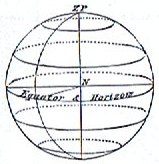
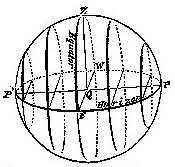
... This type of
fundamental difference in world view will
program minds, and I remember reading that
the Chinese kept constructing their mills
with a horizontal axle instead of with a
vertical axle, as the Europeans they were in
contact with tried to persuade them to do
...
Another alternative was to let the vertical
dimension characterize one half of the
picture and the horizontal dimension the
other half ('twin'):

At right, above the great double-rimmed
wheel, similar to the nightside Sun symbol
around
autumn equinox at the Mad Dog,
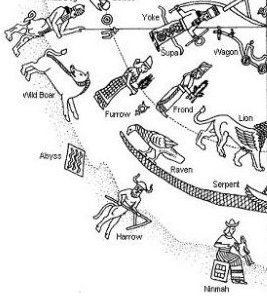
there was a person inside a kind of jar, which could indicate the presence of
Water.
And at left in the picture we can perceive a
design formed from the quincunx pattern,

... Later on in this series of rituals, the
Chorti go through a ceremony they
call raising the sky. This ritual takes
place at midnight on the twenty-fifth of
April and continues each night until the
rains arrive. In this ceremony two diviners
and their wives sit on benches so that they
occupy the corner positions of the cosmic
square. They take their seats in the same
order as the stones were placed, with the
men on the eastern side and the women on the
west. The ritual actions of sitting down and
lifting upward are done with great precision
and care, because they are directly related
to the actions done by the gods at Creation.
The people represent the gods of the four
corners and the clouds that cover the earth.
As they rise from their seats, they
metaphorically lift the sky. If their
lifting motion is uneven, the rains will be
irregular and harmful
...
although
here oriented low at left and high at right.
In the center (or to be more precise to the
right of the quincunx) was a Tree, standing
close to a
head-gear with a 'light-bulb' below (in the
southwest) and with blackness at
the top - like the symbol for the New Moon
(●).
... But in the fullness of time an obscure
instinct led the eldest of them towards the
anthill which had been occupied by the
Nummo. He wore on his head a head-dress and
to protect him from the sun, the wooden bowl
he used for his food. He put his two feet
into the opening of the anthill, that is of
the earth's womb, and sank in slowly as if
for a parturition a tergo. The whole
of him thus entered into the earth, and his
head itself disappeared. But he left on the
ground, as evidence of his passage into that
world, the bowl which had caught on the
edges of the opening. All that remained on
the anthill was the round wooden bowl, still
bearing traces of the food and the
finger-prints of its vanished owner, symbol
of his body and of his human nature, as, in
the animal world, is the skin which a
reptile
has shed ...
A piece of cloth hides the top of the Tree,
covering the gap between High Sky, Air, and Fire,
and the dark time with plenty of Water.
On Easter Island we can in the twin pair of
ceremonial staffs ao and ua recognize High respectively Low:

... The 'pontificial world' (Pontifical
Mundo) has Peru at the top and Spain at
bottom, in both cases with the central
edifices occupying the place of the Sun.
Wright explains: [This is] Waman Puma's
conception of the relationship between Peru
and Spain according to the Andean duality
principle of Hanan (Upper) and
Hurin (Lower). Each country is shown as
a Tawantinsuyu - four quarters with a
capital in the center. Peru is higher,
closer to the sun, and therefore full of
gold, the 'sweat of the sun'
...
|
Ao. Large
dance paddle. 1. Command, power,
mandate, reign: tagata ao,
person in power, in command, ruler.
2. Dusk, nightfall. 3. Ao nui,
midnight. 4. Ao popohaga,
the hours between midnight and dawn.
Aô,
to serve (food); ku-âo-á te kai i
ruga i te kokohu, the food is
served on a platter. Vanaga.
1. Authority,
kingdom, dignity, government, reign
(aho); topa kia ia te ao,
reign; hakatopa ki te ao, to
confer rank; ao ariki,
royalty; ka tu tokoe aho, thy
kingdom come. PS Mgv.: ao,
government, reign. Mq.: ao,
government, reign, command. Sa.:
ao, a title of chiefly dignity;
aoao, excellent, surpassing,
supreme. 2. Spoon; ao oone,
shovel. 3. Dancing club T. 3.
Aonui (ao-nui 2),
midnight. 4. Pau.: ao, the
world. Mgv.: ao, id. Ta.:
ao, id. Mq.: aomaama, id.
Ma.: ao, id. 5. Pau.: ao,
happy, prosperity. Mgv.: ao,
tranquil conscience. Ta.: ao,
happiness. 6. Mgv.: ao,
cloud, mist. Ta.: ao, id.
Mq.: ao, id. Sa.: ao,
cloud. Ma.: ao, id. 7. Mgv.:
ao, hibiscus. 8. Ta.: ao,
day. Mq.: ao, day from dawn
to dark. Sa.: ao, id. Ma.:
ao, id. 9. Ta.: ao, a
bird. Ha.: ao, id. 10. Mq.:
ao, respiration, breath. Ha.:
aho, breath. 11. Mq.: ao,
to collect with hand or net. Sa.:
ao, to gather. Ma.: ao,
to collect. Ta.: aoaia, to
collect food and other things with
care. Churchill. |

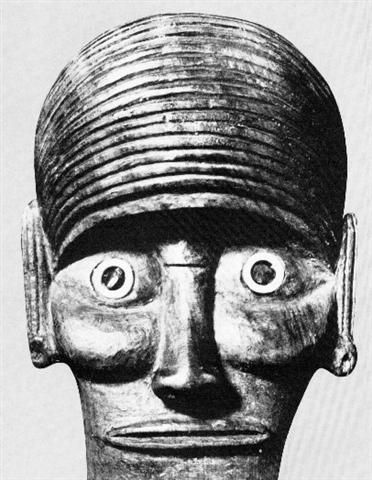
|
Rapa. 1.
To shine; shiny, polished;
he-rapa te moai miro, the wooden
figurine is shiny, polished. 2.
Emblem, badge of timo îka
(person entrusted with putting a
death spell on an assassin).
Rapahago, name of a spirit (akuaku),
anciently considered as benevolent;
rapahago, a fish. Raparapa,
to dazzle; dazzled: he-raparapa
te mata. Marîa raparapa,
calm, smooth shiny sea. Vanaga.
1. Pau.: rapa,
a fool, madness. Ma.: rapa, a
familiar spirit. 2. Pau.: rapa,
blade of a paddle. Mgv.:
raparapahoe, id. Ta.: rapa,
id. Mq.: apa, id. Sa.:
lapa, flat. Ma.: rapa,
flat part of a shovel. 3. Pau.:
rapae, a sand-pit. Ta.: rape,
arapai, id. 4. Mgv.:
rapahou, primipara. Ma.:
rapoi, id. 5. Mgv.: raparapa,
green. Ta.: rapa, id. 6.
Mgv.: raparapa, flat. Ta.:
rapa, a flat rock. Sa.:
lapalapa, a flat coral. Ma.:
raparapa, the flat part of the
foot. 7. Ta.: raparapa,
square. To.: labalaba, id.
Ha.: lapalapa, square (of
timber, of a bottle, of a cow yard).
Churchill. |
|
Ua. 1.
Cause, reason why something happens
or is done; he ûa te ua, au
i-ta'e-iri-ai ki tooku hare,
because of the rain, I did not go
home; ua kore, without cause,
without reason. 2. Ceremononial
stave with a human face carved at
one extremity. Vanaga. Cfr toko.
1. A long club T. 2. Mgv.: ua,
the genitalia. Ta.: hua, id.
Mq.: hua, id. Ha.: hua,
testicles. 3. Ta.: ua, the
back of the neck. Ma.: ua,
id. Sa.: ua, the neck. 4.
Ta.: ua, a land crab which
shears iron. Ma.: uka,
lobster. Sa.: uga, the hermit
crab. Churchill.
Ûa. Rain;
1. ûa hakamito, persistent,
but not strong, rain; 2. ûa kura,
fine rain, drizzle; 3. ûa
matavaravara, strong rain; 4.
ûa parera, torrential rain; 5.
ûa tai, rain followed by fair
weather at sea. Ehu ûa,
drizzle. Vanaga.
Ûaûa.
Tendons, muscles. 1. Hau ûaûa
kio'e, line made from rats'
tendons. 2. Ûaûa toto, vein,
artery. 3. Ûaûa piki, spasm.
Vanaga. 1. Rain; hoa mai te ua,
to rain; mou te ua, to cease
raining. P Mgv., Mq., Ta.: ua,
rain. 2. Vein, artery, tendon (huahua
1) (uha
G);
ua nene,
pulse;
ua nohototo, artery,
ua
gaei, pulse.
Uaua,
vein, tendon, line;
kiko
uaua, muscle T.
Hakauaua, to mark with
lines. P Pau.:
tare-ua, tendon. Mgv.,
Mq., Ta.:
uaua,
vein, tendon. Churchill.
U'a. Of
the tide, to reach its maximum;
tai u'a, high tide. Vanaga.
Wave, surge; tai ua, high
tide. Churchill.
Uá. Ata uá, morning twilight.
Uáuá, to
reside; resident; noho uáuá
to settle somewhere; ina koe ekó
noho uáuá, do not establish
yourself there. Vanaga. |
As to the curious head-gear (wooden bowl)
remaining on the ground we should consider
*Ca14-23:
 |
 |
 |
 |
 |
 |
|
*Ca14-18 |
*Ca14-19 |
*Ca14-20 (383) |
*Ca14-21 (392 - 8) |
*Ca14-22 |
*Ca14-23 |
|
te honu paka |
te henua |
honu kau |
te mata |
te honu |
kua heheu |
|
1h (15.2)
β
Phoenicis (15.1), υ Phoenicis, ι
Tucanae (15.6), η Ceti, ζ
Phoenicis (15.7) |
Al Batn Al Hūt-26 (Belly of the
Fish) /
Revati-28 (Prosperous) / 1-iku
(Field Measure)
MIRACH (Girdle) = β Andromedae,
KEUN MAN MUN (Camp's South Gate)
= φ Andromedae
(16.0),
ANUNITUM = τ Piscium
(16.5),
REVATI (Abundant) = ζ Piscium
(16.9)
REGULUS (α Leonis)
|
ν
Phoenicis (17.4), κ Tucanae
(17.6) |
no star listed (18) |
ADHIL (Garment's Train) = ξ
Andromedae
(19.3), θ Ceti (19.7) |
KSORA (Knee) = δ Cassiopeiae
(20.1), ω Andromedae (20.6), γ
Phoenicis (20.8) |
|
April 5 (460) |
6 (8 + 88) |
7 |
8 |
9 (464 = 99 + 365) |
10 (100) |
|
372 |
373 = 365 + 8 |
374 |
375 |
376 = 464 - 88 |
377 |
|
... The ordinary year in the
previous Roman calendar
consisted of 12 months, for a
total of 355 days. In addition,
a 27-day intercalary month, the
Mensis Intercalaris, was
sometimes inserted between
February and March. This
intercalary month was formed by
inserting 22 days after the
first 23 or 24 days of February;
the last five days of February,
which counted down toward the
start of March, became the last
five days of Intercalaris. The
net effect was to add 22 or 23
days to the year, forming an
intercalary year of 377 or 378
days ... |
|
At the time when Betelgeuze
(*88) was at 0h Regulus would
have culminated (at 21h) in 8
January and this was 160 (= 80 +
88 - 8) days before Betelgeuze
would rise with the Sun. This
distance was in principle
(disregarding the proper motions
of the stars) preserved through
the millenia and at the time of
rongorongo Betelgeuze rose in
day 168 (= 80 + 88), i.e. in
June 17, with Regulus
culminating (at 21h) in April 6
(96) which was 168 - 96 = 72
days earlier. 72 = 360 / 5 and
360 - 72 = 288 (October 15):
... The Julian calendar day
Thursday, 4 October 1582 was
followed by the first day of the
Gregorian calendar, Friday, 15
October 1582 (the cycle of
weekdays was not affected)
...
And according to Manuscript E
the double-canoe of Hotu A
Matua arrived to Easter
Island in 15 October:
... The canoes of Ava Rei Pua
and of Hotu were seen
near the (off-shore) islets. On
the fifteenth day of the month
of October (tangaroa
uri) the canoe of Hotu
and the canoe of Ava Rei Pua
landed. On the fifteenth day of
the month of October (tangaroa
uri), Nonoma left
the house during the night to
urinate outside. At this point
Ira called out to
Nonoma, 'Look at the canoe!'
Nonoma ran, he quickly
went to Te Hikinga Heru
(a ravine in the side of the
crater Rano Kau) and
looked around. There he saw the
double canoe way out near the
(offshore) islets, and the two
(hulls of the canoe) were lashed
together. He ran and returned to
the front of the house. He
arrived and called into the
house: 'Hey you! This canoe has
arrived during the night without
our noticing it!' Ira
asked Nonoma, 'Where is
the canoe, which you say is
lying out there (in the water)?'
Nonoma's voice came back:
'It is out there (in the water)
close to the (offshore) islets!
There it lies, and the two
(hulls) are lashed together.'
The four of them (corrected for
'the six of them') went out and
picked up leaves (on branches)
to give signals. They picked
them up, went and arrived at
Te Hikinga and saw the
canoe. Raparenga got up,
picked up the leaves, took them
in his hands, and waved, waved,
waved, waved
...
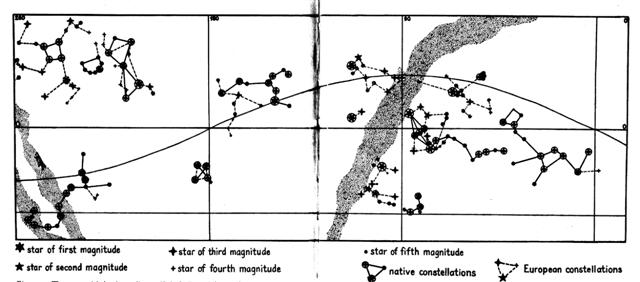 |
It was the eldest of them who sank down and left
his head-gear - like the abandoned skin
of a serpent - lying on the ground. The
eldest of the planets ought to have been
Jupiter (Father Light)
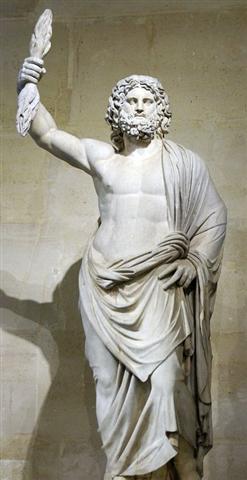
and probably Nonoma corresponded to Jupiter:
|
Sons of Hau Maka |
Sons of Hua Tava |
|
Ira |
Sun |
Kuukuu |
Mars |
Nga Tavake A Te Rona |
|
Raparenga |
Moon |
Ringiringi |
Mercury |
Te Ohiro A Te Runu |
|
|
Nonoma |
Jupiter |
|
Uure |
Venus |
|
Makoi |
Saturn |
Nonoma
(a name resembling Nummo) was out in the night
urinating and in the South American star
map above we can see Leo
'urinating' (resembling Uure). The Babylonian star map
has the
symbol of Jupiter below the face of the
Lion and further down was the wing of
the Hydra (water serpent) - fire
and water were complementary - like the
pair of hulls of a double-canoe:

Nonoma was out urinating in the
Ravine (fissure, ava) and this
could have meant where water
terminated:
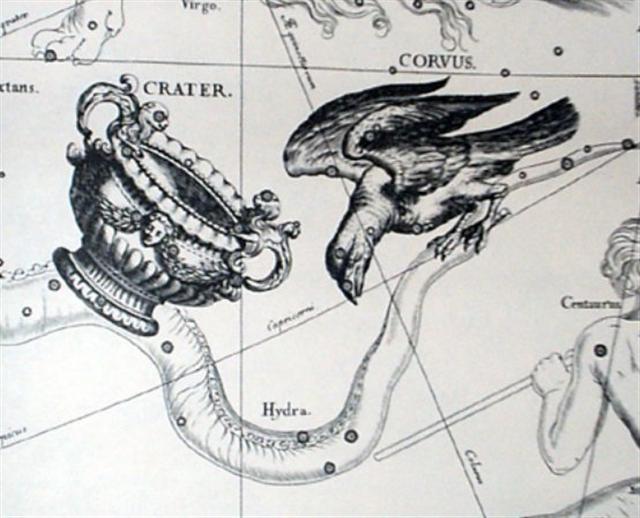
To be more precise - the
ravine
Te Hikinga Heru
probably was
where the path of the Sun (and the other
planets) crossed the 'flow of urine' from
Leo, which was cut off at the ecliptic:
.jpg)
|
Heu.
Offspring of
parents from two different
tribes, person of mixed
descent, e.g. father Miru,
mother Tupahotu.
Heuheu, body hair
(except genitals and armpits).
Vanaga. 1. Heheu; ivi
heheu, the cachalot, bone
needle; hakaheu, spade,
to shovel, to grub up, to
scratch the ground, to labor;
rava hakaheu,
laborious, toilsome. 2.
Hakaheu, affair. Churchill.
M. Heu,
to separate, to pull asunder;
the eaves of a house; heu,
a single hair; hau. to
hew; heru, to comb;
huru, hair on the body;
down; feathers; maheu,
scattered; maheuheu,
shrubs; mahuru, scrub;
heuea, to be separated. Text
Centre.
Nonoma ran, he quickly
went to Te Hikinga Heru
(a ravine in the side of the
crater Rano Kau) and
looked around. There he saw the
double canoe way out near the
(offshore) islets, and the two
(hulls of the canoe) were lashed
together. |
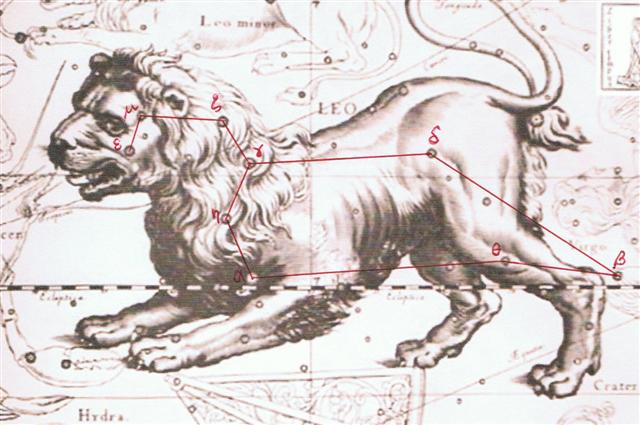
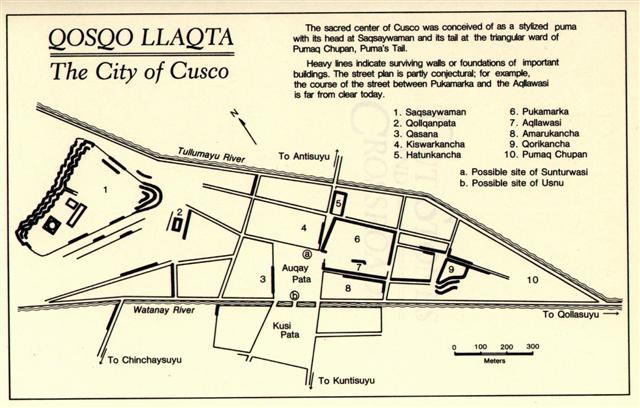
|
















.jpg)

